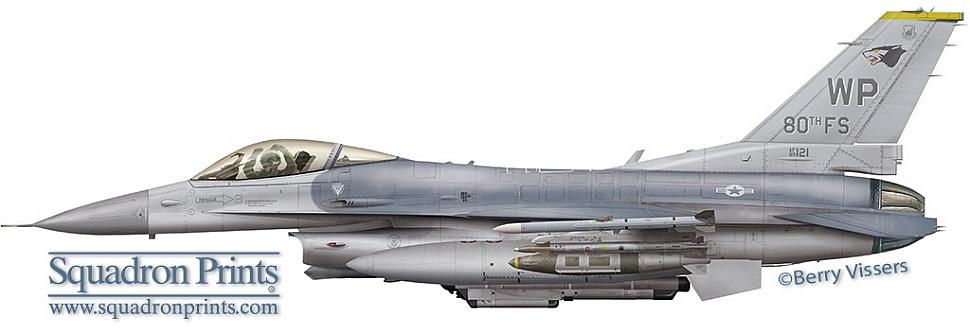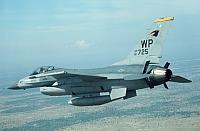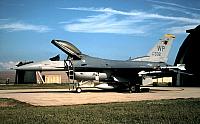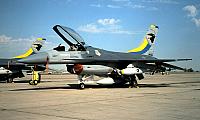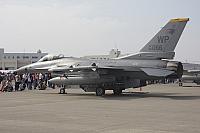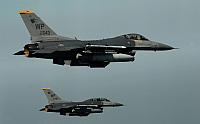 |
80th Fighter Squadron ( USAF PACAF)" Juvats" |
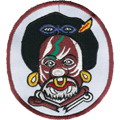 |
80 FS " Juvats" ( USAF PACAF) | |||
| Status: |
Active
|
|||
| Version: | F-16C/D block 40 | |||
| Role: | Air Defense, Attack | |||
| Tailband: | Gold | |||
| Motto: | What is Good? | |||
| Badge: | N/A | |||
F-16 History
Starting in 1981 the 80th TFS started to receive Vipers to replace the F-4D Phantoms. Factory fresh F-16A/B block 15s were delivered over that year. The USAF always saw that the Korean based units received the newest technology first. Korea at that time was at least as important as the European theatre. The squadron was tasked with air defense as well as both conventional attack as nuclear strike. In late 1987 the squadron again received band-new F-16s, this time C and D models of the block 30 version. They had the so-called ‘big inlet’ from the start gaining the full extent of the General Electric F110 engine. The squadrons’ F-16A/B block 15s were sent to Shaw & Moody AFB. The mission of the squadron remained practically the same.
In its history the squadron has flown the exact same models of aircraft as its sister squadron, the 35th FS. However, the 80th would remain in the block 30 while the 35th FS converted to the block 40 in 2000. This did give the 8th FW more flexibility by offering two distinctive capabilities that the different blocks offered. This ultimately changed in January of 2008 when the 80th FS gave up its block 30s to the newly formed 18th AS and received their block 40s from when the squadron was a normal fighter squadron. So as of 2008 the 8th FW flew both the block 40 versions.

Ushering in a new era for F-16 operations with the unit was the conversion to block 40 airframes. In 2008 the squadron received block 40s. This meant the squadron’s task changed somewhat as advanced targeting both during the day and night became possible. By that time the squadron had already given up its strike task, which was abandoned back in 1991.
Aircraft Markings History

The tail consist of a gold tailband with the 'WP' tailcode in the center - meaning Wolf Pack - and the serial underneath with the colored PACAF logo underneath the tailband.
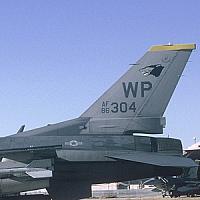
With the introduction of the C/D models the design was changed slightly. The PACAF logo was retained but in toned down colors and a wolfs head - which previously adorned the side of the airframe - was moved to the tail and placed between the tailcode and PACAF logo.
Unit History
- 1942: Activation of the squadron in Mitchell Field, New York
- 1942: P-39 'Airacobra' (part of 8 PG)
- 1942: P-39 'Airacobra' (Brisbane [Aus.])
- 1942: P-39 'Airacobra' (Lowood [Aus.])
- 1942: P-39 'Airacobra' (Petric [Aus.])
- 1942: P-39 'Airacobra' (part of 8 FG, Port Moresby [N. Gui.])
- 1942: P-39 'Airacobra' (Milne Bay [N. Gui.])
- 1943: P-38 'Lightning' (Mareeba [Aus.])
- 1943: P-38 'Lightning' (Port Moresby [N. Gui.])
- 1943: P-38 'Lightning' (Dobodura [N. Gui.])
- 1944: P-38 'Lightning' (Cape Gloucester [N. Brit.])
- 1944: P-38 'Lightning' (Nadzab [N. Gui.])
- 1944: P-38 'Lightning' (Owi [Indo.])
- 1944: P-38 'Lightning' (Morotai [Indo.])
- 1944: P-38 'Lightning' (Dulag [Phil.])
- 1944: P-38 'Lightning' (San Jose [Phil.])
- 1945: P-38 'Lightning' (Fukuoka [Jap.])
- 1945: Deactivated
- 1947: Activation of the squadron in Itazuke [Jap.]
- 1947: P-51 'Mustang' (part of 8 FG)
- 1947: P-51 'Mustang' (Ashiya AB [Jap.])
- 1949: P-51 'Mustang' (Itazuke AB [Jap.])
- 1950: P-80C 'Shooting Star' (part of 8 FBG, Kimpo AB [S. Kor.])
- 1950: P-80C 'Shooting Star' (Itazuke AB [Jap.])
- 1951: P-80C 'Shooting Star' (Kimpo AB [S. Kor.])
- 1951: P-80C 'Shooting Star' (Suwon AB [S. Kor.])
- 1953: F-86F 'Sabre'
- 1954: F-86F 'Sabre' (Kadena AB [Jap.])
- 1956: F-100D/F 'Super Sabre' (Itazuke AB [Jap.])
- 1958: F-100D/F 'Super Sabre' (part of 8 TFW)
- 1963: F-105D 'Thunderchief'
- 1964: F-105D 'Thunderchief' (part of 41 AD, Yokota AB [Jap.])
- 1964: F-105D 'Thunderchief' (Korat AB [Thai.])
- 1965: F-105D 'Thunderchief' (part of 6441 TFW, Takhli AB [Thai.])
- 1966: F-105D 'Thunderchief' (part of 41 AD)
- 1968: F-105D 'Thunderchief' (part of 347 TFW, Osan AB [S. Kor.])
- 1968: F-4C 'Phantom II'
- 1971: F-4D 'Phantom II' (part of 3 TFW, Kunsan AB [S. Kor.])
- 1974: F-4D 'Phantom II' (part of 8 TFW)
- 1981: F-16A/B 'Fighting Falcon'
- 1987: F-16C/D 'Fighting Falcon'
- 1992: F-16C/D 'Fighting Falcon' (part of 8 FW)
- 1994: F-16C/D 'Fighting Falcon' (part of 8 OG)
F-16 Airframe Inventory
- All 80 FS F-16s in our F-16 Aircraft Database (past and current aircraft)
- Current 80 FS F-16s in our F-16 Aircraft Database
Photos
Please use this form to add any list any error or omissions you find in the above text.
Note: your comments will be displayed immediately on this page. If you wish to send a private comment to the webmasters, please use the Contact Us link.

